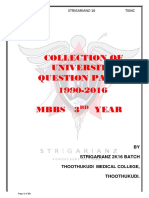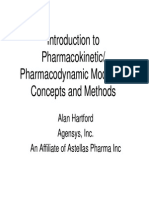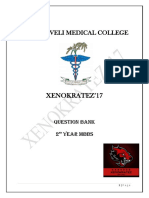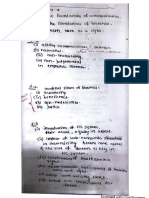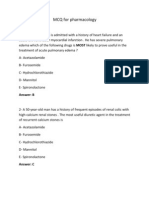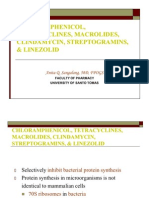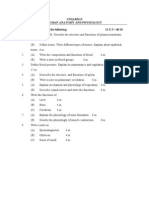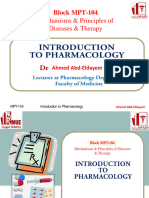Pharmacology Questions
Pharmacology Questions
Uploaded by
liaqat ahmedCopyright:
Available Formats
Pharmacology Questions
Pharmacology Questions
Uploaded by
liaqat ahmedCopyright
Available Formats
Share this document
Did you find this document useful?
Is this content inappropriate?
Copyright:
Available Formats
Pharmacology Questions
Pharmacology Questions
Uploaded by
liaqat ahmedCopyright:
Available Formats
According to the Punjab University College of Pharmacy (PUCP) Past papers (2015-2021)
PHARMACOLOGY AND THERAPEUTICS-I
(THEORY)
PAST PAPER QUESTIONS
UNIT:1 GENERAL PHARMACOLOGY
1. Define the following terms: (05 each) (A/2015)
a. Pharmacokinetics and pharmacodynamics.
b. Agonist , Antagonist, and partial antagonist
c. Volume of distribution and clearance of drug.
d. Drug receptor and mechanism of action of drug
(c) PHARMACOKINETICS
1. What is biotransformation? Discuss phase I and phase II metabolic reactions.
(20) (A/2015,16,17,19,21) (2nd A/2016,18)
2. What is bioavailability? What factors can modify the bioavailability of the
drugs. (20) (A/2016)
3. What is drug absorption? Discuss different ways by which drug can be
transported across the membranes. (20) (2nd A/2017)
4. Define pharmacokinetics. Describe the absorption of drugs. State the factors
which can affect the absorption of drugs. (20) (2nd A/2018)
(d) PHARMACODYNAMICS
1. What are the different classes of receptors. Discuss G-protein coupled
receptors GPCRS in detail. (20) (A/2016)
2. Describe main classes of receptor and discuss ligand-gated ion channels
thoroughly. (20) (2nd A/2016, A/2018 )
3. Classify receptors. Give detailed account of ligand gated ion channels. (20)
(A/2017)
Prepared by: Ahmad Raza (ASCP-02)
Mubeen Bilal (ASCP-47)
According to the Punjab University College of Pharmacy (PUCP) Past papers (2015-2021)
4. Write down the pharmacology of proton pump inhibitors. (10) (A/2017, 2 nd
A/2018)
5. Discuss G-protein coupled receptors in details. (20) (2nd A/2017)
6. What are the different classes of receptors. Discuss G protein coupled
receptors. (20) (A/2018)
7. Discuss the structure and signaling of kinase linked receptors. Give
examples. (20) (2nd A/2018)
8. Classify receptors. Give a comprehensive account of inotropic receptors.
(10) (A/2019)
9. Discuss Briefly: (05+05+05+05+05) (A/2021)
a. Cholinergic receptors with their distribution.
b. Ligand-gated ion channels
c. Treatment of organophosphorus poisoning.
d. Therapeutic uses of atropine
UNIT:2 DRUGS ACTING ON AUTONOMIC NERVOUS
SYSTEM (ANS)
1. Classify Anti-muscarinic drugs. Discuss ATROPINE with respects to its
mechanism of action effect and different organic systems and toxicity. (20)
(A/2015)
2. Classify Beta Adrenergic Blockers therapeutic uses side effect and contra
indications of PROPONALOL. (20) (A/2015)
3. Classify Anti-muscarinic drugs. Discuss mechanism of action,
pharmacological properties, toxicity and therapeutic uses of ATROPINE.
(20) (A/2016)
4. Classify direct acting sympathomimetics. Discuss EPINEPHRINE with
respect to its mechanism of action, effects of different organ/systems toxicity
and contraindication. (20) (A/2016)
5. Classify β-adrenergic blockers discuss mechanism of action, therapeutic uses
side effect and contraindication of Propranolol. (20) (2nd A/2016)
6. Classify muscarinic receptors agonists. Describe mechanism of action
therapeutic uses and adverse effect of these agents. (20) (2nd A/2016)
7. Write short notes on: (10+10) (2nd A/2016)
a) Prazosin
b) Digoxin
Prepared by: Ahmad Raza (ASCP-02)
Mubeen Bilal (ASCP-47)
According to the Punjab University College of Pharmacy (PUCP) Past papers (2015-2021)
8. Classify Para sympathomimetic. Give mechanism of action therapeutic uses
and toxicity of Physostigmine. (20) (A/2017)
9. Classify sympathomimetic. Give the pharmacology of Epinephrine. (20)
(A/2017)
10. Discuss the pharmacology of Captopril. (10) (A/2017)
11. Classify Anti-muscarinic drugs. Give mechanism of action, therapeutic uses
and toxicity of Atropine. (20) (2nd A/2017)
12. Classify sympatholytic drugs. Discuss propranolol in details. (20) (2nd
A/2017)
13. Give the mechanism of action therapeutic uses and adverse effects of the
following: (5+5+5+5) (A/2018)
a) Prazosine
b) Dobutamine
c) Succinylcholine
d) Ephedrine
14. Give the mechanism of action therapeutic uses and adverse effects of the
following (5+5+5+5) (2nd A/2018)
a) Physostigmine
b) Phenoxybenzamine
c) Pilocarpine
d) Reserpine
15. Give the therapeutic uses of drugs affecting parasympathetic nervous
nd
system. (10) (2 A/2018)
16. Discuss the pharmacological action therapeutic uses and toxicity of
Atropine. (10) (2nd A/2018)
17. Describe types of cholinergic receptors. Their distribution on signal
transduction pathways. Classify Anti-muscarinic drug and explain their
therapeutic uses and adverse effects. (20) (A/2019)
18. Classify Adrenergic Receptors steps of their signals transduction pathways.
Distribution of adrenergic receptors in body and therapeutic uses of
adrenergic agonists and antagonists. (10) (A/2019)
19. Illustrate and explain mechanism of control of pupil diameter.
Accommodation and intraocular pressure. Also describe ocular
pharmacology of cholinergic and adrenergic drugs. (10) (A/2019)
20. Describe synthesis, storage and release of nor-Adrenaline from adrenergic
neurons and various drugs affecting the pathways. (10) (A/2021)
Prepared by: Ahmad Raza (ASCP-02)
Mubeen Bilal (ASCP-47)
According to the Punjab University College of Pharmacy (PUCP) Past papers (2015-2021)
21. Classify different types of adrenergic receptors. Explain their signal
transduction pathways. Describe MOA, pharmacokinetics, adverse effects,
contraindications and therapeutic uses of Epinephrine. (10) (A/2021)
22. Classify Anti-cholinergic drugs. Describe MOA, pharmacological
properties, therapeutics uses, adverse effects, drug interactions of atropine.
(20) (A/2021)
23. Discuss Briefly: (05+05+05+05+05) (A/2021)
a. Cholinergic receptors with their distribution.
b. Ligand-gated ion channels
c. Treatment of organophosphorus poisoning.
d. Therapeutic uses of atropine
UNIT:3 DRUGS ACTING ON GASTROINTESTINAL TRACT
(GIT)
1. Classify Anti-ulcer drugs. Discuss the mechanism of action, therapeutic uses
side effect of PROTO PUMP INHIBITIONS. (20) (A/2015)
2. Write notes on: (10+10) (A/2016)
a. Nitroglycerine
b. Irritant laxatives
3. Classify Anti-ulcer drugs and enumerate detailed pharmacology of these
drugs. (20) (2nd A/2016)
4. Define Emesis give the mechanism of action and therapeutic uses of Anti-
emetic drugs. (10) (A/2017)
5. Give the pharmacology of Anti-diarrheal drugs. (10) (2nd A/2017)
6. Classify the drugs used in constipation and discuss prokinetics agents in
detail. (10) (2nd A/2018)
7. Define Emesis? Discuss the pharmacology of 5HT3 receptors antagonists.
(10) (2nd A/2018)
UNIT:4 AUTOCOIDS AND THEIR ANATAGONISTS
1. Write Short note on: (07, 07, 06) (A/2015)
a. Digoxin
b. Prostaglandians
c. Irritant purgatives
Prepared by: Ahmad Raza (ASCP-02)
Mubeen Bilal (ASCP-47)
According to the Punjab University College of Pharmacy (PUCP) Past papers (2015-2021)
2. Define Autacoids? Give in detail the effects of histamine and Anti-histamine
on different organs. (20) (2nd A/2016)
3. Discuss H2 receptors antagonists. (10) (2nd A/2017)
4. Classify Anti-histamines and discuss their pharmacology. (10) (2 nd A/2018)
UNIT:5 DRUGS ACTING ON RESPIRATORY SYSTEM
1. What is Asthma? Classify Anti-asthma drugs and discuss pharmacology of
leukotriene antagonist lgE anti bodies in details. (20) (A/2016)
2. Classify Anti-asthmatic drugs. Give the pharmacology of leukotriene
receptors antagonistic. (20) (A/2017)
3. Write note on the following. (20) (2nd A/2017)
a. Potassium sparing diuretics
b. Salbutamol
4. Classify Bronchodilators? Discuss in detail pharmacology of beta 2 agonists
and Methylxanthines. (20) (A/2018)
5. Classify Anti-asthma drug write in detail pharmacology of Theophylline.
(20) (A/2019)
6. Classify the drugs used in treatment of bronchial asthma. Explain
mechanism of action adverse effect contraindications and therapeutic uses of
BETA-2 Adrenergic agonists. (20) (A/2021)
UNIT:6 DRUGS ACTING ON CARDIO-VASCULAR SYSTEM
(CVS)
1. Classify Anti-hyperlipidemic drugs. Discuss the pharmacology of
SIMVASTATIN. (20) (A/2015)
2. Classify Diuretics. Describe mechanism of action, effects on renal
hemodynamics adverse effects and therapeutic uses of Spironolactone.
(20) (A/2016)
3. Describe the mechanism of action and therapeutic uses of Amiodarone. (10)
(A/2017) HINT: Amiodarone is an anti-arrhythmic drug.
4. What is congestive heart failure, give the pharmacology of Digoxin. (20) (2nd
A/2017)
Prepared by: Ahmad Raza (ASCP-02)
Mubeen Bilal (ASCP-47)
According to the Punjab University College of Pharmacy (PUCP) Past papers (2015-2021)
5. Define Angina pectoris? Explain in details the mechanism of action of Anti-
anginal drugs, (20) (A/2018)
6. What do you understand by cardiac arrhythmias? Discuss various kinds of
arrhythmias? Explain anti-arrhythmic drugs in details. (20) (A/2018, 2nd
A/2018)
7. What do you understand by hypertension? Classify Anti-hypertensive
drugs? Explain calcium channels blockers and ACE inhibitors in detail.
(20) (2nd A/2018)
8. What do you understand by Cardiac Failure. Explain Digitalis glycosides in
details. (20) (2nd A/2018)
9. Discuss the mechanism of action of Class I and II anti-arrhythmic drugs.
(10) (2nd A/2018)
10. Define angina pectoris? Explain in detail the mechanism of action of anti-
anginal drugs. (20) (2nd A/2018)
11. Define angina pectoris. What are the major types of angina. Classify Anti-
angina drugs and discuss the Nitrates in detail. (20) (A/2019)
12. Give the classification of diuretics. Explain mechanism of action uses
adverse effects and toxicity of furosemide. (10) (A/2019)
13. Define hypertension and its stages. Classify Anti-hypertensive drugs and
discuss role of Diuretics & Angiotensin II receptors Blockers in detail.
(20) (A/2021)
14. Write note on the following. (20) (2nd A/2017)
a. Potassium sparing diuretics
b. Salbutamol
UNIT:7 DRUGS ACTING ON GENTIO-URINARY SYSTEM
N/A
UNIT:8 ANTI-ANAEMIC DRUGS
N/A
UNIT:9 HORMONES, ANTAGONIST AND OTHER AGNETS
AFFECTING ENDOCRINE FUNCTIONS
N/A
Prepared by: Ahmad Raza (ASCP-02)
Mubeen Bilal (ASCP-47)
You might also like
- Pharma Rapid Course E01 (Medlive by DR Priyanka)Document412 pagesPharma Rapid Course E01 (Medlive by DR Priyanka)bushrawrites1010167% (3)
- SRZ 3rd Year 1990-2016Document19 pagesSRZ 3rd Year 1990-2016G RAVIKISHORE50% (2)
- Pharmacokinetic Pharmacodynamic Modeling & Simulation PDFDocument70 pagesPharmacokinetic Pharmacodynamic Modeling & Simulation PDFSadia SajidNo ratings yet
- APAP-McNeil Package-2002Document127 pagesAPAP-McNeil Package-2002qiuy99No ratings yet
- Pharma 10 Years-1Document15 pagesPharma 10 Years-1Dheeraj Garg100% (1)
- Question Bank For Pharmacology IIDocument8 pagesQuestion Bank For Pharmacology IIPrashant JadhavNo ratings yet
- Question of PharmacologyDocument17 pagesQuestion of PharmacologyPrabhatSinghNo ratings yet
- XENOKRATEZ'17 - 2nd Year Question BankDocument210 pagesXENOKRATEZ'17 - 2nd Year Question BankJohithNo ratings yet
- Pharmacology 5 Years Past PapersDocument1 pagePharmacology 5 Years Past PapersBukhari BukhariNo ratings yet
- Question Bank For Pharmacolgy-II T.Y.B.pharmDocument4 pagesQuestion Bank For Pharmacolgy-II T.Y.B.pharmChandrashekhar Singh0% (1)
- Pharmacology Haqs 3rd EdDocument32 pagesPharmacology Haqs 3rd EdmeghanahimnishNo ratings yet
- Short Answers Type QuestionsDocument2 pagesShort Answers Type QuestionsNaman GoyalNo ratings yet
- Pyq 2nd Year Ques (2010-2023)Document71 pagesPyq 2nd Year Ques (2010-2023)abhirup.mondal110No ratings yet
- Pharmacology MD Question Papers ManipalDocument2 pagesPharmacology MD Question Papers Manipalgurudot100% (1)
- PH Col-II Sem V-Pharmacology-2Document7 pagesPH Col-II Sem V-Pharmacology-2Vishnu VichuZNo ratings yet
- Pharmacology-I II Pharm.D. Question BankDocument6 pagesPharmacology-I II Pharm.D. Question BankAnanda Vijayasarathy100% (2)
- 4 - Pharmacology-II QP BankDocument8 pages4 - Pharmacology-II QP BankMadhu Kiran DhondalayNo ratings yet
- MBBS Second Year Pathology Paper-I Important Question BankDocument11 pagesMBBS Second Year Pathology Paper-I Important Question BankAakansh Maheshwari 1100% (1)
- Appliedmicro Micro D& R AgamDocument83 pagesAppliedmicro Micro D& R Agamjanijkson29No ratings yet
- Question Bank - 3rd Prof, Part - II MbbsDocument174 pagesQuestion Bank - 3rd Prof, Part - II MbbsAnindya BiswasNo ratings yet
- Diploma in Pharmacy (Part - II) Examination Hospital & Clinical PharmacyDocument3 pagesDiploma in Pharmacy (Part - II) Examination Hospital & Clinical PharmacymifuoNo ratings yet
- PK-Factors Prolonging Drug Action-1Document18 pagesPK-Factors Prolonging Drug Action-1Manikanta GupthaNo ratings yet
- mbbs2 Pharmacology Record-17072017Document129 pagesmbbs2 Pharmacology Record-17072017drsujeetkumar5869No ratings yet
- Pharmacology Viva BookletDocument31 pagesPharmacology Viva Bookletgjkknn jkkbbbnNo ratings yet
- KGMU Pathology (2000-2020)Document10 pagesKGMU Pathology (2000-2020)Prepladder ChyNo ratings yet
- I. Practicals: Practical Exam Pattern For Ii Mbbs Pharmacology Cbme Batch (2019)Document2 pagesI. Practicals: Practical Exam Pattern For Ii Mbbs Pharmacology Cbme Batch (2019)santhoshNo ratings yet
- Pharmacology Question PapersDocument26 pagesPharmacology Question PapersShane Rodriguez25% (4)
- Anti LeproticDocument9 pagesAnti LeproticMeenakshi shARMANo ratings yet
- Pathology Solved Papers 2015Document35 pagesPathology Solved Papers 2015Lakshmi Venkataraman100% (3)
- Imp Questions in PharmacologyDocument5 pagesImp Questions in PharmacologyBeerasandrapalyaRangaiahRavikumar100% (3)
- MUHS Last 10 Yrs MD Pharmacology QuestionsDocument7 pagesMUHS Last 10 Yrs MD Pharmacology QuestionsSagar Gavankar100% (1)
- SPOTTERS 1st Internal PharmaDocument38 pagesSPOTTERS 1st Internal PharmaSurya HotaNo ratings yet
- Dams - Last Look - P.S.M.Document9 pagesDams - Last Look - P.S.M.skNo ratings yet
- GPAT Pharmaceutical Inorganic Chemistry SyllabusDocument1 pageGPAT Pharmaceutical Inorganic Chemistry Syllabuskumar HarshNo ratings yet
- Important Topics For MicrobiologyDocument9 pagesImportant Topics For MicrobiologyPrabhatSinghNo ratings yet
- Practical Lab Manual: Pharmacology - Iii B. PharmDocument16 pagesPractical Lab Manual: Pharmacology - Iii B. PharmPrincipal, Spectrum Hi Pharmacy College, Sultanpur100% (1)
- Pharmacology AetcomDocument3 pagesPharmacology Aetcomsanjanajaiswal14503No ratings yet
- Pathology Imp QuestionsDocument4 pagesPathology Imp QuestionsDevAshish BNo ratings yet
- Autacoids Analgesics DR H AboshoushaDocument7 pagesAutacoids Analgesics DR H AboshoushaMoustafa HazzaaNo ratings yet
- Case Scenarios University DR - NerveDocument24 pagesCase Scenarios University DR - NerveSREE NITHINNo ratings yet
- LA & GA by SakshiDocument43 pagesLA & GA by SakshiSakshi sdpcNo ratings yet
- Antileprotic DrugsDocument15 pagesAntileprotic DrugsDhananjay Verma100% (1)
- Pharmacotherapy of ShockDocument23 pagesPharmacotherapy of ShockIgor Stefanet100% (2)
- ADRnewReporting Form 1.4Document2 pagesADRnewReporting Form 1.4Sourabh kundara50% (2)
- MCQ For PharmacologyDocument6 pagesMCQ For PharmacologyTasneem Elwaleed100% (2)
- Analeptic DrugDocument23 pagesAnaleptic DrugKhadim Mohiuddin100% (1)
- Book List CbsDocument12 pagesBook List CbsDrSantosh TarkeNo ratings yet
- ChronopharmacologyDocument3 pagesChronopharmacology0921pyNo ratings yet
- 101MCQsinPharmacology 27.01.2017Document2 pages101MCQsinPharmacology 27.01.2017NOorulain HyderNo ratings yet
- Bhalani New Pathology 3456 - 67392Document6 pagesBhalani New Pathology 3456 - 67392shreyas mhapadi100% (1)
- Hormones Pharmacology by IGMRIDocument97 pagesHormones Pharmacology by IGMRIclaw foreSK TeamNo ratings yet
- Microbiology of CVSDocument44 pagesMicrobiology of CVSsultan khabeebNo ratings yet
- Sample - Career As A Pharmacist2Document10 pagesSample - Career As A Pharmacist2Rahu BiNo ratings yet
- 44 Chloramphenicol Tetracyclines Macrolides ClindamycinDocument63 pages44 Chloramphenicol Tetracyclines Macrolides ClindamycinrupalisyanNo ratings yet
- Drugs Used in AsthmaDocument33 pagesDrugs Used in AsthmaNathanNo ratings yet
- Central Nervous System Mnemonics (Rifao) : Sedative HypnoticsDocument11 pagesCentral Nervous System Mnemonics (Rifao) : Sedative HypnoticsHassan AhmadNo ratings yet
- Forensic Guidelines by Mbbs Cafeteria-1Document30 pagesForensic Guidelines by Mbbs Cafeteria-1Usama HameedNo ratings yet
- I Pharm D Human Anatomy and PhysiologyDocument2 pagesI Pharm D Human Anatomy and Physiologyvyshnosudha100% (3)
- Definition of Social PharmacyDocument7 pagesDefinition of Social PharmacyShraddha PharmacyNo ratings yet
- Pharmacy Important QuestionsDocument9 pagesPharmacy Important QuestionsDr.j.sakthi Varshini 103No ratings yet
- PYQ Patho MPMSU MBBSDocument20 pagesPYQ Patho MPMSU MBBSShahzaib Gouri100% (1)
- Handbook of Essential Pharmacokinetics, Pharmacodynamics, and Drug Metabolism For Industrial ScientistDocument302 pagesHandbook of Essential Pharmacokinetics, Pharmacodynamics, and Drug Metabolism For Industrial Scientistdavid_dung100% (3)
- 4 Semester Syllabus PDFDocument12 pages4 Semester Syllabus PDFbansalabhinav142No ratings yet
- Lecture 1 Introduction To PharmacologyDocument20 pagesLecture 1 Introduction To Pharmacologybeneficialboxer9237No ratings yet
- Drug Dosing in Hemodialysis: Katie Cardone, Pharmd, Bcacp, FNKF, Fasn Associate Professor of Pharmacy PracticeDocument44 pagesDrug Dosing in Hemodialysis: Katie Cardone, Pharmd, Bcacp, FNKF, Fasn Associate Professor of Pharmacy PracticeGregNo ratings yet
- Part 1 Pharm ModuleDocument49 pagesPart 1 Pharm ModuleJojo JustoNo ratings yet
- Oxytocin - DrugBankDocument10 pagesOxytocin - DrugBankAli RonaldoNo ratings yet
- Adverse Drug ReactionsDocument54 pagesAdverse Drug ReactionsAprilVivienCu100% (4)
- WEEK 1 Drug Development and Ethical ConsiderationsDocument142 pagesWEEK 1 Drug Development and Ethical ConsiderationsMaureen CuartoNo ratings yet
- Holze 2023Document10 pagesHolze 2023Ramiro Manzano NúñezNo ratings yet
- Introduction To PharmacologyDocument11 pagesIntroduction To PharmacologyMaryam ElammaryNo ratings yet
- Lecture 1 PharmacodynamicsDocument55 pagesLecture 1 PharmacodynamicsAuthor Nauman ShadNo ratings yet
- MT6314 1st LessonDocument7 pagesMT6314 1st Lessonlanceferdinand.tan.pharmaNo ratings yet
- Biopharmaceutics and Pharmacokinetics-A Treatise BrahmankarDocument206 pagesBiopharmaceutics and Pharmacokinetics-A Treatise BrahmankarLakshmi Kumari90% (10)
- Adverse Drug Reaction: Classification Predisposing Factors MechanismDocument46 pagesAdverse Drug Reaction: Classification Predisposing Factors MechanismSreya SanilNo ratings yet
- modMODULE II-D MUSCARINIC CHOLINORECEPTOR ANTAGONISTSDocument6 pagesmodMODULE II-D MUSCARINIC CHOLINORECEPTOR ANTAGONISTSKenneth NuñezNo ratings yet
- Pharmacology For NursesDocument2 pagesPharmacology For Nursesjoy abuan100% (1)
- Drug Receptor InteractionDocument4 pagesDrug Receptor InteractionKholah RizwanNo ratings yet
- Prodrug Delivery PDFDocument6 pagesProdrug Delivery PDFanantachoudhuryNo ratings yet
- IND Data Requirements and US FDA Submission ProcessDocument10 pagesIND Data Requirements and US FDA Submission ProcessProRelix InfoNo ratings yet
- Pharma S01 SBR03 Le01Document12 pagesPharma S01 SBR03 Le01sky vallartaNo ratings yet
- Introduction To PharmacologyDocument30 pagesIntroduction To PharmacologyCandy crush100% (1)
- Edwards Sharon Axe Sue 10 Rs of Safe Multidisciplinary Drug Administration PDFDocument9 pagesEdwards Sharon Axe Sue 10 Rs of Safe Multidisciplinary Drug Administration PDFNimrod Bautista SolosaNo ratings yet
- Pharmacology Prelim TransesDocument12 pagesPharmacology Prelim TransesMarth Jasmine M. AllejosNo ratings yet
- Course Guide PHARMADocument26 pagesCourse Guide PHARMAREYJAN APOLONIONo ratings yet
- Learning Plan: Pharmacology and Therapeutics First Semester AY 2020 - 2021Document6 pagesLearning Plan: Pharmacology and Therapeutics First Semester AY 2020 - 2021Kenneth NuñezNo ratings yet
- PN-Chapter 2-Introduction To Drug ActionDocument52 pagesPN-Chapter 2-Introduction To Drug ActionmysNo ratings yet
- Gatwech Dech RutDocument16 pagesGatwech Dech RutGatwech DechNo ratings yet
- Concepts of Bypass Protein Feeding in RuminantsDocument57 pagesConcepts of Bypass Protein Feeding in Ruminantswiwiih doangNo ratings yet

